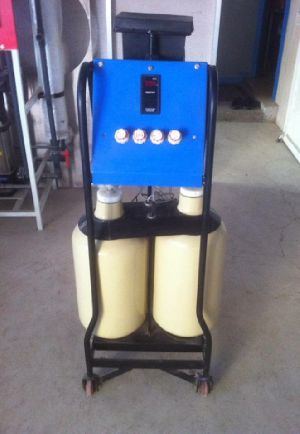
Mini Dm Plant
Get Price Quote
Portable or Mini DM water plant: The flow rate of mini DM plant is 50 – 80 litre per hour and space required for it is very compact. These plants have a wide range of applications in food and pharmaceutical industry, automobiles industry, hotels, clubs, residential complexes, laboratories and so on. The plants are available in competitive prices. A pre-validated and pre-mounted skid mounted solution is offered by mini DM water plant. Application areas are Chemicals, industries, battery top-up and laboratory and research centres.

Demineralized Water System
Get Price Quote
A Demineralisation Plant consists of two pressure vessels containing cation and anion exchange resins. Various types of ion exchange resins can be used for both the cation and the anion process, depending on the type of impurities in the water and what the final water is used for.Typically, the cation resin operates in the hydrogen cycle. The cations in the water (i.e. calcium, magnesium and sodium) pass through the cation exchange resin where they are chemically exchanged for hydrogen ions.The water then passes through the anion exchange resin where the anions (i.e. chloride, sulphate, nitrate and bicarbonate) are chemically exchanged for hydroxide ions.The final water from this process consists essentially of hydrogen ions and hydroxide ions, which is the chemical composition of pure water. The simplified demineralisation plant consists of:Composite resin vessels with charge of strong cation and anion resin; control-panel encompassing a conductivity measurement and alarms, etc; acid and caustic injection facility from bulk, semi-bulk or carboy containers.
Best Deals from Demineralisation Plants

Demineralisation Plant
Get Price Quote
The clients in India as well as abroad can avail hi-tech Demineralisation Plant from us. The Demineralisation Plant, we manufacture is a Two-bed water de-ioniser and is made as per the set standards of the industry. The clients can avail the Demineralisation Plant from us in varied specifications as per the requirement. The running costs of the Demineralisation Plant come out to be very low and it is designed for consistent qualitative performance. Details Consists of two FRP/MS rubber lined pressure vessels that are connected in series along with its internal fittings1st vessel consists of strongly acidic cation exchange resin that converts the positive ions of salt and replaces them with hydrogen the ions to form respective acidsThe formed acids are absorbed in the next vessel by strongly basic anion exchanges resin

Dm Plants
Get Price Quote
Dm Plants, automatic water plants, bt filling machine, Pet Blowing Machine

ion exchange plant
Get Price Quote
ion exchange plant, Carbon Products, Frp Vessels, Industrial Valves

Dm Water Plant
Get Price Quote
Water Treatment Equipment, Ro Water Treatment Plant, RO Membranes

Dm Water Plant
Get Price Quote
Iron Removal System, Solenoid Valve, Pumps, disk strainers and nozzles

Demineralization Plants
Get Price Quote
Demineralization Plants, softening plants

Electrodeionization System
Get Price Quote
Accelarated Evaporation System

Capacitive Deionization Water treatment systems
Get Price Quote
Capacitive Deionization Water treatment systems, smart water meters

Filtration Plant
Get Price Quote
Filtration Plant, Gas Chlorinator, Gas Chlorination System

Water Filtration Plants
Get Price Quote
Water Filtration Plants, Pressure Transmitter, Swimming Pool Filters